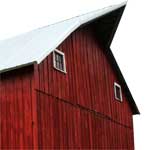Comprised of Illinois, Wisconsin, Indiana, Iowa, Kansas, Michigan, Minnesota, Missouri, Nebraska, North Dakota, South Dakota and Ohio – our American Midwest is known as the breadbasket of the world, for good reason. Test your knowledge about our contribution to the world food supply and issues currently in the spotlight. No Peeking! Answers posted below.
Quiz Questions
1. Illinois is a leading producer of what three food products?
a. swine, grapes and corn
b. apples, corn and cattle
c. soybeans, corn and swine
d. buckwheat, ostriches and fish
2. Which three states together produce more than half of the nation’s corn?
3. For what purpose is 80 percent of Midwestern corn used?
a. animal feed b. tortilla chips
c. high fructose corn syrup d. ethanol
4. Soybeans are an important crop for many reasons. Which is not a reason?
a. They contain high protein content
for animal feed.
b. Soybeans are super tasty.
c. Their oil is used for food and fuel.
d. They’re used to make ink, crayons,
foam and other non-food products.
5. About 89 percent of Illinois’ cropland is considered prime farmland, ranking the state third nationally in total prime farmland acreage. What makes it so good?
6. Which is not a factor in successful Midwest farming?
a. ample flat terrain
b. rich soil quality
c. highly changeable climate
d. irrigation by mountain snowmelt
7. What’s the average age of an
Illinois farmer?
a. 30s b.40s c.50s d.60s
8. Which of these is NOT one of the five most abundant U.S. crops?
a. corn b. soybeans c. wheat
d. alfalfa e. cotton f. rice
9. In the American grain business, what does GMO mean?
10. Who owns most Illinois farms?
11. Define the term “sustainable agriculture.”
12. Which Midwestern state produces more eggs and Swiss cheese than any other state in the nation?
a. Ohio b. Nebraska c. Minnesota d. Indiana
13. “Organic” is the leading food growth sector, increasing 20 percent each year, but just what does the term mean?
14. America loses more than an acre of farmland every minute, according to the American Farmland Trust. Which is not a reason for this?
a. urban sprawl
b. erosion
c. natural disasters
15. In Thomas Jefferson’s day, farmers made up about 90 percent of the U.S. workforce. What percentage do they represent today?
16. What’s a CAFO and why is the concept so controversial?
17. Which Midwestern state has more organic and grass-based dairy farms than any other?
18. What are IP specialty grains?
19. Why are some consumers worried about rapid consolidation within the food industry?
20. The number of U.S. farms with dairy cows fell 88 percent between 1970 and 2006, according to the U.S. Department of Agriculture. Why?
Quiz Answers
1. C. Illinois is a leading producer of soybeans, corn and swine.
2. Iowa (19 percent), Illinois (18 percent) and Nebraska (11 percent). Source: United States Department of Agriculture (USDA).
3. A. Animal feed, both domestic and international. However, corn also finds its way into products ranging from ketchup, Twinkies and cheese to Kool-Aid, diapers and peanut butter. Source: U.S. Environmental Protection Agency (US EPA).
4. B. Soybeans aren’t known for their flavor.
5. Much of our mostly flat terrain is covered with soil that developed from loess, a fine, porous, substance left here by wind and glaciers millions of years ago. Source: Illinois Department of Agriculture (IDA).
6. D. Irrigation by mountain snowmelt is not a factor in Midwest farming.
7. C. 50s. Source: IDA
8. Rice. Just 3 million acres of rice are grown by about 9,000 farms compared to corn and soybeans at 72 million acres each; nearly 60 million acres of hay; and 53 million acres of wheat. Cotton (13 million) and Sorghum grain (7.7 million) are next. However, even though the United States grows just 1 percent of the world’s rice, we’re the second-leading rice exporter, supplying 18 percent of the world’s market. Source: U.S. EPA.
9. GMO stands for Genetically Modified Organism (sometimes GEO, Genetically Engineered Organism). Many markets, including Japanese and European, are wary of genetically modified foods. In Europe, all food with greater than 0.9 percent of approved GMO must be labeled. In the United States and Canada, there is no requirement to label GMOs, either plant or animal. Source: U.S. EPA.
10. Individuals and families own more than two-thirds of all U.S. farm acreage, according to the U.S. Department of Commerce. However, the rise of large factory farms, both livestock and grain, is making it difficult for smaller operations to compete. According to the IDA, there are only 76,000 farm operators in Illinois today, compared with 164,000 in 1959. Between 1974 and 2002, the number of corporate-owned U.S. farms increased by more than 46 percent, according to the USDA.
11. “Sustainable Agriculture” is the idea of using farming practices that don’t deplete, erode or contaminate soil and water resources on or near the farm.
12. Ohio produces more eggs and Swiss cheese than any other state. Source: American Farmland Trust
13. The USDA defines “organic” foods as those grown without the use of synthetic fertilizers, pesticides, sewage sludge, antibiotics or hormones. Animals must be fed 100 percent organic feed and provided outdoor access and pasture. No genetically modified organisms are used and food is not irradiated.
14. C. Natural disasters
15. Fewer than 1 percent of Americans farm as their principal occupation and only about 2 percent live on farms. Source: US EPA.
16. CAFO stands for Concentrated Animal Feeding Operation, also commonly called “factory farm.” A CAFO has a very large and condensed population (usually indoors) of confined animals that are not allowed to graze. To maximize profit and combat health problems and pests caused by crowded conditions, animals are treated with antibiotics, growth hormones and pesticides. CAFOs also produce as much waste as small cities, laced with the above chemicals, and are a leading source of water pollution in many states. Source: Wikipedia
17. Wisconsin
18. Identity Preservation (IP) grains are defined by “careful handling of the grain from seed to harvest, processing and transportation to customer delivery. Under strict identity-preserved grain handling, at no point are the grains mixed or co-mingled with other grains. The system is designed to preserve the quality and consistent identity of premium value grains.” Source: Midwest Shippers Association
19. Just 2 percent of livestock farms now raise 40 percent of all animals in the United States, according to Sustainable Table, a nonprofit organization that advocates for local sustainable food. Some consumers worry that monopoly agribusinesses are putting smaller farmers out of business, degrading food quality, polluting fresh water sources, treating animals inhumanely and making our food supply easier to sabotage.
20. Milk production per cow doubled between 1970 and 2006, due, in part, to widespread use of genetically engineered bovine growth hormone, also called rBGH (banned in Europe due to studies which link it to cancer in humans) and more frequent mechanized milking sessions. Also, while there are fewer farms, average farm sizes have grown dramatically, some housing more than 15,000 dairy cows. Source: USDA ❚
























































